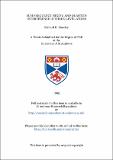Files in this item
Sum frequency mixing and quantum interference in three-level atoms
Item metadata
| dc.contributor.advisor | Dunn, Malcolm H. | |
| dc.contributor.advisor | Sinclair, Bruce | |
| dc.contributor.author | Moseley, Richard R. | |
| dc.coverage.spatial | 253 p. | en_US |
| dc.date.accessioned | 2018-06-06T10:00:17Z | |
| dc.date.available | 2018-06-06T10:00:17Z | |
| dc.date.issued | 1995-07 | |
| dc.identifier.uri | https://hdl.handle.net/10023/13753 | |
| dc.description.abstract | This work contains theoretical and experimental studies of the properties of three-level atoms subjected to two single-frequency, continuous-wave laser sources with special emphasis on magnetic-field-induced sum frequency mixing (SFM) and electromagnetically-induced transparency (EIT). In sodium vapour, two resonant-enhancement routes for SFM were experimentally studied. In one route (3S-3P-3D) the output is generated on a quadrupole-allowed transition and on the other (3S-3P-4P), a dipole-allowed transition. Phase matching conditions are studied in detail. On the second route, the two contributions to the phase mismatch can combine to heavily distort the spectroscopic lineshapes observed. Doubly-resonant SFM is considered and two paths for excitation of the output coherence are identified. Control of their relative strength, via the input laser strengths, is predicted, as well as interference between them. These are both experimentally observed on the 3S1/2-3P1/2-3D3/2 transition scheme in sodium. Theory is presented to show how the use of a strong upper laser in resonant SFM can, by EIT, greatly reduce the absorption on the lower transition without similarly reducing the nonlinear process. A significant increase in conversion efficiency is predicted. Theory is also presented on the inclusion of the local field correction, which is relevant for high vapour densities, in the Bloch equations for the three-level atom. Nonlinear coherence cross-coupling terms arise and the generalised equations are then used for two case studies; one concerning EIT, the other SFM. EIT is experimentally studied using continuous-wave lasers in rubidium vapour. Focusing and de-focusing were observed on the probe laser beam as it tunes through the transparency window at close, but separate, detunings. This is attributed to the radial intensity profile of the coupling laser which imposes a spatial refractive index modulation on the medium at the probe laser wavelength. | en_US |
| dc.language.iso | en | en_US |
| dc.publisher | University of St Andrews | |
| dc.subject.lcc | TK7871.3G3M7 | |
| dc.subject.lcsh | Lasers | |
| dc.title | Sum frequency mixing and quantum interference in three-level atoms | en_US |
| dc.type | Thesis | en_US |
| dc.type.qualificationlevel | Doctoral | en_US |
| dc.type.qualificationname | PhD Doctor of Philosophy | en_US |
| dc.publisher.institution | The University of St Andrews | en_US |
This item appears in the following Collection(s)
Items in the St Andrews Research Repository are protected by copyright, with all rights reserved, unless otherwise indicated.

